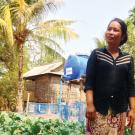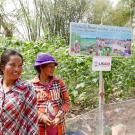Success story: Natural resource management and conservation agriculture with vegetable
Reducing drudgery, improving soil for vegetable farmers
Most commonly used with field crops, conservation agriculture combines three practices that help farmers invest in soil health, specifically:
- minimal soil disturbance (“no till”),
- continuous mulch cover, and
- rotating diverse crops.
These practices can also reduce labor and reduce water evaporation from the soil.
Manuel Reyes, professor at North Carolina Agricultural and Technical State University, has helped farmers in many countries improve their soil and use water efficiently. In doing so, he has also partnered with three Feed the Future Innovation Labs, funded by the U.S. Agency for International Development.
Beginning in 2010, Reyes started working with farmers in Cambodia on conservation agriculture for field crops, with an international team supported by the SANREM Innovation Lab. Two year later, the team worked with 56 households over 149 hectares to use conservation agriculture principles.
After testing conservation agriculture practices with vegetable crops in the United States, Reyes expanded his conservation agriculture work in Cambodia to focus on vegetable farmers. Now with additional funding from the Horticulture Innovation Lab, he added drip irrigation to conservation agriculture practices for vegetable the farmers. This research sought to find whether combining these practices could reduce labor needs, increase yield, increase income and ultimately receive support from vegetable farmers.
For field trials in Cambodia, women farmers grew a variety of vegetables, including string beans, cucumber, Chinese cabbage, kale, tomatoes and eggplant. Unlike the first few years of using conservation agriculture with field crops, this trial with vegetables found no significant differences in yields or income between the various treatments.
But what did change with the new practices was the farmers’ labor. The researchers estimate that growing vegetables on 100 square meters with traditional methods and hand watering requires hauling about 1,300 pounds of water per day during the dry season — and even twice as much during very dry seasons. Drip irrigation and conservation agriculture freed the women farmers from carrying water, tilling and weeding.
Many of the women farmers were so pleased with the new practices that they asked to end the experiment early, to avoid the extra labor of tilling, hand-watering and weeding required to maintain the field tests.
The next step? Reyes is working with these Cambodian women farmers on a new Horticulture Innovation Lab project, this time on marketing their vegetables and building a local brand that promotes their conservation practices.


